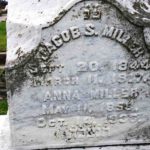 Italo Svevos Segnitz and Galveston Connection.
Italo Svevos Segnitz and Galveston Connection.
November 7th, 2018 was a slightly cloudy Wednesday on Galveston Island. That day I placed two small stones on Anna Miller’s headstone in the Hebrew Benevolent Society Cemetery of this well-preserved historical treasure and former capital of Texas. Anna Miller was born Anna Herz on May 11, 1858 in Ludwigsburg in the Kingdom of Württemberg and died on October 14, 1938 at the age of 80 in Houston. She was since then remembered as the mother of two children and the second wife of Galveston textile entrepreneur Jacob S. Miller (*Sept. 20, 1844 – March 11, 1917), whom she had married around 1884 after his first wife had died at the age of only 23 in 1882.
But to the literary world and unbeknownst to her descendants until recently, Anna Herz was also the youthful crush of Aron, called Ettore Schmitz, who was known for most of his life as a businessman in Trieste and London, but led a double life as the now famous Austro-Italian (Triestine) writer Italo Svevo (= “Italus the Swabian”, i.e. the Staufer [il Svevo, gli Svevi] or German). Svevo was a friend of James Joyce, to whom he served as a role model for Leopold Bloom in his novel Ulysses. As teenagers, both Anna Herz and Ettore Schmitz had lived in the same house in Segnitz-am-Main in Franconia from spring 1874 to autumn 1878, where they shared their love of literature.
Almost 150 years later, the full story can now be told about how the future writer Italo Svevo discovered his love for literature in a tiny village in northern Bavaria in Germany – and also the stories of some remarkable people who influenced and encouraged him.
So far, nothing else was known about “Anna Herz from Frankenthal” (her mother’s hometown) than what had been passed on in the Schmitz family from the memories of Ettore (*1861–1928) and his brother Adolfo (*1860–1918), and from a remarkable diary and pieces of family history written by their younger brother Elio (*1863–1886).
The Schmitz brothers were in a certain way privileged students in the Brüsselsches Institut (= “Brüssels’s Institute”, named after its founder Julius Brüssel, *1802–1855), a well-known boarding school with students from all over Europe and even from America. Adolfo, Ettore and Elio stayed in tiny rooms in the attic of the so-called Neubau (= “new building”) of the school. This was the headmaster’s residence, in which, in addition to his apartment, there was also a large dining room to which breakfast, lunch and dinner was delivered from the kitchen via a dumbwaiter. Anna Herz and another young lady of probably about the same age (“Signorina Carolina” according to Elio, therefore in German probably Fräulein Karoline) were also staying in this building.
Ettore’s First Amour
Elio Schmitz’ portrayal of Anna Herz as a lovable, well-educated, well-read young woman has fascinated many who have researched Italo Svevo, including my long time friend and Svevo-biographer John Gatt-Rutter. We dedicated our 1996 monograph on Italo Svevo’s youth in his German boarding school “to Anna Herz, unknown” – hoping that her whereabouts and later life would not remain unknown forever. Finally I traced her on August 23, 2017, with the help of Paul Theobald, a fellow historian in Frankenthal. No documents have yet been found in Frankenthal about Ludwigsburg-born Anna Herz (there are, however, many about her relatives), but Anna Miller’s death certificate had then been published online in a genealogy forum in the United States. After the discovery, I immediately sent it to John: “Anna Herz! We found her!” – “That’s brilliant!”
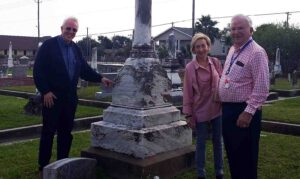
On my visit to the Galveston Jewish Cemetery, I was accompanied by Anna’s great-granddaughter Barbara Eaker, her great-nephew Irwin Herz with his wife, Barbara Herz, and a family friend. Of course I had to explain what the two stones for Anna Herz were all about. One of them came also in John’s name: a round, almost gold-shining Meleke or “Jerusalem-Stone” which I had found some months earlier in the dry city moat of Jerusalen. We do not know if Anna Herz had ever intended to travel to Jerusalem, but what we do know is, that even in secular and progressive Ashkenazim communities as Frankenthal and Segnitz at her time, very few people used the words “Auf Wiedersehen” or alike as a farewell, but rather the traditional wish on Passover Seder (סֵדֶר): LeShana Haba’ah BiYerushalayim (לשנה הבאה בירושלים), Yiddish: “kumedike yor in irushlim” (“Next year in [the rebuilt] Jerusalem!”).
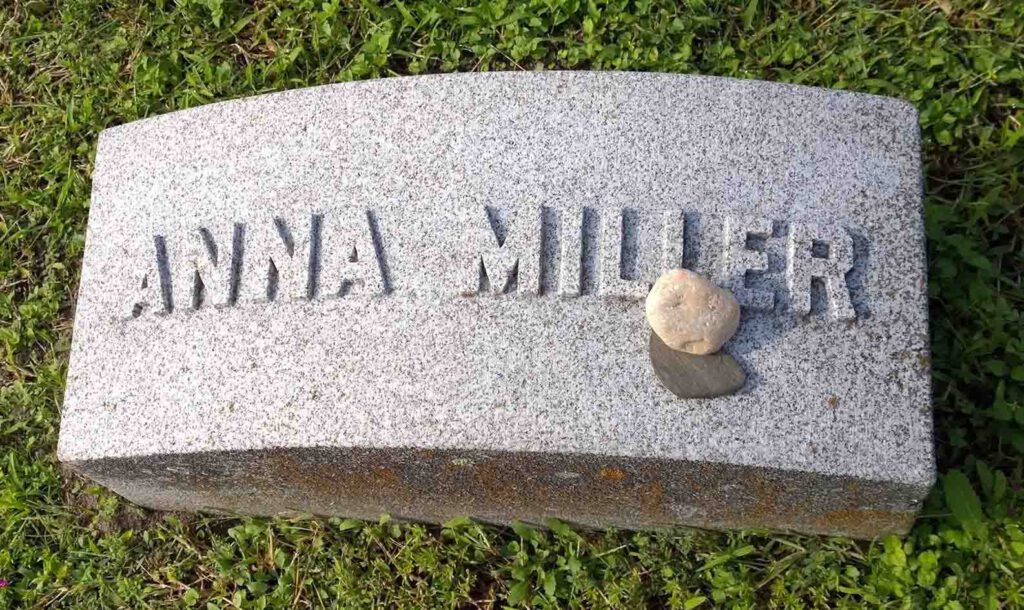 Even as a schoolboy, when I first heard about some customs in the once large Franconian Jewish community, I was impressed by the perseverance, patriotism and awareness of diaspora and tradition that are expressed in these words, hence this particular stone.
Even as a schoolboy, when I first heard about some customs in the once large Franconian Jewish community, I was impressed by the perseverance, patriotism and awareness of diaspora and tradition that are expressed in these words, hence this particular stone.
The second stone was a flat, round-washed shell limestone, a natural toy of the kind that certainly not only I, but probably young people in any time of history, have used for stone skipping. It came from the bank of the Main river in front of the former Curs, the main school building with the classrooms.
Anna Herz was the daughter of Ferdinand Herz (*June 25, 1826 Hochberg-am-Neckar; date of death and location unknown) and Jeanette Herz née Thalmann (*April 25, 1833 Frankenthal – Oct. 6, 1900 Galveston). Jeanette Herz was also the step-grandmother of the lawyer and politician Ludwig Marum (*1882 Frankenthal – 1934 Concentration Camp Kieslau), an early victim of the National Socialist German Workers’ Party after it came to power in 1933.
A school in Germany
Ettore Schmitz was twelve and a half years old when he arrived in Segnitz. He had left Trieste with his brother Adolfo and his parents, Franz and Allegra Schmitz, on May 16, 1874. Franz Schmitz had decided, that his sons must learn German properly.
He always said that a good businessman (and he took it for granted that this is what they would become) ought to have at least a smattering of four languages and to know at least two perfectly – above all German. German was the key to a business career, he used to say, just as German education was the best in the world. (“…lern to write German well”, he wrote to his youngest son Ottavio, years later, when Ottavio was beginning life as a bank clerk in Vienna; “keep yourself clean and tidy, stick to the straight path and pronounce your r’s well, and you will be a made man.”) [P.N.Furbank: Italo Svevo. The Man and the Writer. London 1966, 8.]
At that time, Anna Herz had been in Segnitz already for two years or so to support her aunt Anna Spier née Kaufmann (*Jul. 16, 1852 Frankenthal – Dec. 28, 1933 Göttingen) who had married the politician and boarding school master Samuel Spier (Apr. 4, 1838 Alsfeld – Nov. 9, 1903 Frankfurt am Main) on September 2, 1872 in Segnitz.
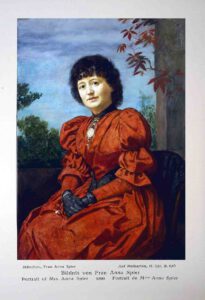
Anna Spier later became one of the first major female art critics in Germany. She also wrote occasional poetry and short stories and published in newspapers and journals as diverse as the New Yorker Staats-Zeitung, the Continental Edition of the Daily Mail, Die Gegenwart, Die Kunst unserer Zeit (“The Art of our Time”) and others. She took part in feminist, literary and atheist discussion groups, and became a close friend of such notable and diverse personalities as Ludwig Pfau, Hans Thoma, Franz von Lehnbach, Fanny zu Reventlow, Karl Theodor Duke in Bavaria, Helene Böhlau, Salvatore Farina, Elly Heuss-Knapp, Lily Braun, Mascha von Kretschman, Edgar Hanfstaengl, Max Born, Otto Driesen, Marie la Roche and Hedwig Pfringsheim (Katia Mann’s mother). At least half a dozen authors published novels, volumes of poetry and art books dedicated to Anna Spier. Helene Böhlau did so even twice and many praised her influence in the prefaces of their books. Elly Heuss-Knapp once compared her with the legendary Salonnière Rahel Varnhagen.
Samuel Spier, who was fourteen years older than his wife, had already made history before he moved to Segnitz. The son of a cloth merchant from Alsfeld in Hesse was one of the founding fathers of the early German democracy movement. Initially a liberal, he became one of the most influential figures in the General German Workers’ Association (ADAV) and in the Social Democratic Workers’ Party (SdAP) between 1868 and 1871. As early as 1868, against the will of the ADAV leadership which had become authoritarian at the time, Spier had established the first contacts with the leaders of the Saxon People’s Party in Leipzig and discussed the possibilities of cooperation with Wilhelm Liebknecht and August Bebel.
On June 22nd, 1869 they had a legendary meeting “in a third-class inn in Magdeburg” as Bebel later had it in his memories: Four “ADAV rebels”, led by Spier and Wilhelm Bracke, and the leaders of the Saxon People’s Party, Bebel and Liebknecht, drafted the call to found a new party on a billiard table – this time fundamentally democratic – at a “General German Social-Democratic Workers’ Congress” in Eisenach in August. There it was Spier again who, with numerous speeches, demanded and implemented the internal democratic structure of the newly founded party which is still valid today. At the suggestion of Liebknecht, Spier (not Bebel, as you may sometimes read) was elected to head the party and became its first chairman. At the subsequent congress of the First Socialist International in Basel he campaigned emphatically and successfully with Liebknecht and Moses Hess for the definition of the goals of separating church and state and separating school from church.
A Place for Exile
But after the Lötzener Kettenaffäre (= “Lötzen chain affair”), a sensational high treason trial during and after the Franco-Prussian war, which developed into the first Sozialistenprozeß (“socialist trial”) in the newly founded German Reich and lasted for one and a half year until February 1872, Spier withdrew from party leadership and bought the Segnitz boarding school, where he remained, according to Elio Schmitz, “in a kind of political exile” – indeed for a full decade.
The “chain affair’s” trigger was a manifesto of September 5, 1870, that the party committee – i. e. Spier and his close friend Wilhelm Bracke – was responsible for. It was published after the Battle of Sedan on September 1st and 2nd, 1870 and the capture of Napoleon III. In the face of the Paris Commune they now advocated a fair peace treaty with France without the annexation of Alsace-Lorraine. Over 10,000 copies of the manifesto were printed and distributed throughout the German Confederation.
Spier, Bracke, their secretary named Leonhard von Bonhorst who had actually drafted the text (he was a political hotspur who was frequently arrested during his political speeches), some other party members and even the printer, a completely apolitical person, were subsequently arrested, put in chains and abducted to the Boyen fortress near Lötzen, more than 1000 kilometers away at the extreme end of East Prussia, hence the name of this “affair”. They all spent several months in prison without compensation, although in the end, in February 1872 – and despite Bismarck’s efforts and pressure to the contrary –, they could only be charged (with difficulty) for what was basically a ridiculously minor offense against the Association Law: Prussian associations were forbidden from being members of the International Workers’ Association.
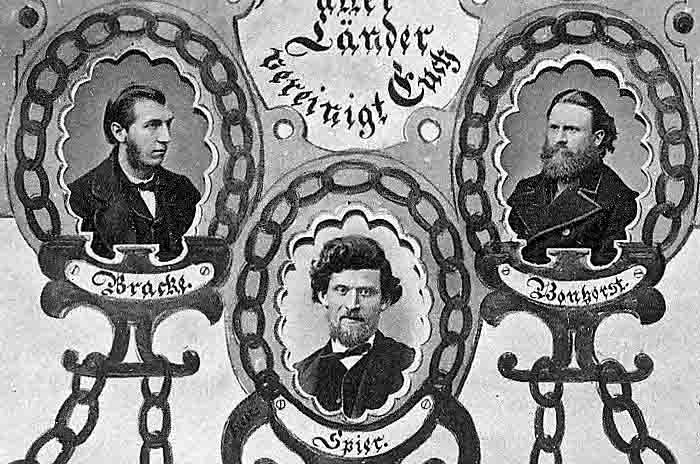
While beeing imprisoned, Spier had lost part of his sizable inherited fortune, because he was deliberately prevented from going about his business. He did not subsequently change his view of the world, but he did change his life plan: “Independence is of the utmost importance in public socio-political activity,” he wrote to his friend Albert Baumgarten, a lawyer and politician in Wolfenbüttel, on June 21, 1871. Spier had withdrawn from party leadership after narrowly missing out on entry into parliament in the Mittweida district in Saxony in the first elections to the Reichstag in March 1871 against the well-known national liberal Karl Biedermann (* 1812, † 1901), who had been set up especially against him. Even so, and despite the fact that he had still been in prison and could not campaign for votes, Spier had won the most votes of any candidate within the party leadership. Only Bebel, who was not a party leader, but had been (with Liebknecht) a member of parliament for the Saxon People’s Party already in the 1860s, got more votes than Spier and became the only MP of the newly founded party in the Reichstag, after another socialist candidate, Reinhold Schraps, had left the party and voted with the liberal People’s Party, after he was elected. Even Liebknecht didn’t make it.
Spier seems to have chosen Segnitz very consciously for his “exile”. He had already been a teacher there in the early 1860s and now bought the flourishing boarding school at the height of its importance (with up to 172 students from all over the world) from his previous employer Dr. Simon Louis Eichenberg (*1829 Adelebsen – 1889 Marktbreit), Julius Brüssel’s son-in-law. It was actually Eichenberg, not the early deceased Brüssel, who had made the boarding school so well known. In addition to his very successful running the school, Louis Eichenberg, who, like Spier and Wilhelm Liebknecht, had studied in Giessen, was also a far-sighted local politician and a generous man who set up two charitable foundations in Segnitz, one for the Jewish and one for the Protestant community. A contemporary newspaper article also tells us that Eichenberg gave a highly acclaimed speech at the victory celebration after the end of the Franco-Prussian War, after all the teachers and students of the Brüsselsches Institut had previously taken part in a parade. He also mastered the art of ein großes Haus zu führen (= “entertaining in style”). His wife had her own companion in addition to the domestic staff and was generally addressed as “Madame”. When she died in 1909, the Community of Segnitz (now without any Jewish inhabitants) received another Eichenberg legacy, the interest of which was to benefit the local poor.
As for the school’s real estate, it apparently took Spier a few years to pay for it, as the school was officially transferred from Eichenberg to Spier only in 1875. From this point on there was a remarkable change: Spier consistently implemented his old political demand for the separation of school and church and banned religious instruction from his newly edited school brochure in 1876, in which religion under Eichenberg had officially always ranked first. It is especially interesting, that the protestand priest in Segnitz was the official government local school inspector at that time. Eichenberg had extremely good relations with him, while under Spier there were increasing complaints that the boarding school students were not encouraged to take religious instruction. Spier did not want it at the school, but pupils of the various denominations could officially receive their instructions in regular classes outside: Jewish and Protestant pupils in Segnitz, Catholics in Marktbreit.
“A beautiful, little slim lady.”
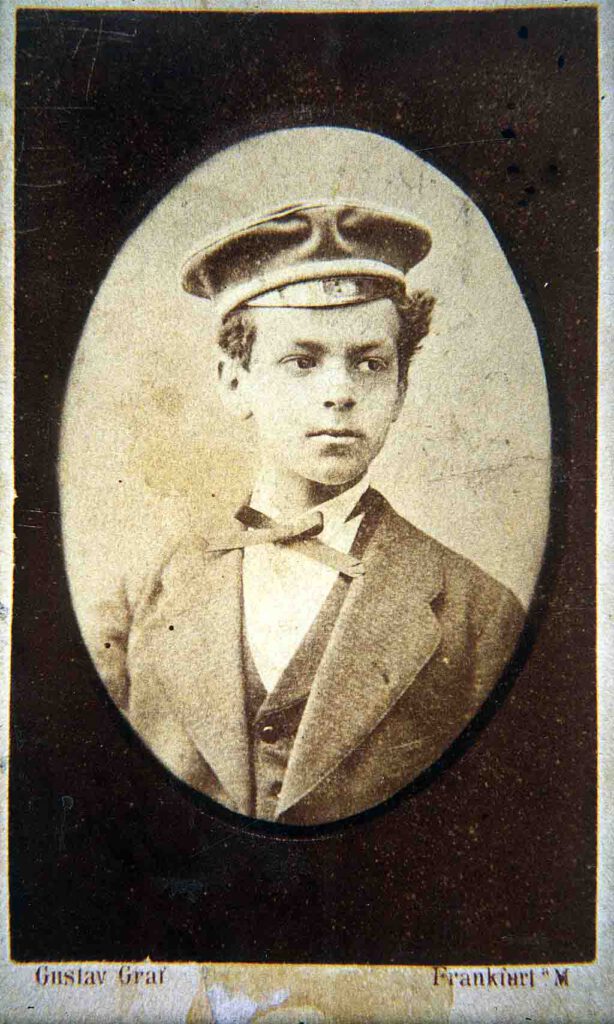
At that time, Anna Herz had been in Segnitz already for about two years. The headmaster’s young wife, who was less than six years older than her niece, had three births within her first three years in Segnitz, with her first child dying after just 18 months. Elio Schmitz reports from his arrival at the end of October 1876, that Anna Herz had to help her then again pregnant aunt walk when she left the house. Samuel and Anna had met during her education in Wolfenbüttel in the Duchy of Brunswick. Samuel was a teacher at the Samsonschule (another famous Jewish founded boarding school) while she was nearby in one of the most progressive educational institutions in Germany for girls between the ages of around seven and eighteen, the Breymannsches Institut. This boarding school, a higher school for girls and a teacher training institute at the same time, had been founded by Henriette Schrader-Breymann and can easily be described as an early haven of experiential education. Samuel and Anna later sent their daughter Else Caroline Spier (*1876–1921) for her education to the same institute.
Adolfo and Ettore Schmitz arrived in Segnitz in May 1874. During their studies which lasted until 1878, they returned only once to Trieste: for summer vacation in 1876. In autumn of this year, Samuel Spier traveled to Austria to pick up two dozen or so students in Trieste and Vienna, among them Elio Schmitz who hadn’t made it two years earlier with his brothers because of his mournfulness and general weakness. When the party arrived in Segnitz at the end of October 1876, Elio was first greeted by Frau Spier who – as well as seemingly everybody else at the school –, had been carefully informed that Elio was, contrary to his brothers, a mama’s boy who would easily feel lonely and get homesick. At the time, Anna Spier was well advanced in pregnancy with her third and last child, who would be born less than a month after.
As we turned towards the so-called Hauptstraße (= “main street”, today Hans-Kesenbrod-Straße), I saw a beautiful woman in black walking towards us, leaning on the shoulder of a young lady. The headmistress kissed Mr. Spier and then lowered herself to ask about me. Mr. Spier pulled me out of the knot of students who stepped back and formed an espalier and led me to his wife, who kissed me and then, after greeting the other students, took me for the rest of the way with her. It seemed to me as if she was giving me a sermon or something like that, of which I didn’t understand a word, but since that evening, from that first conversation, the words she used over and over again have settled in me: Liebes Kind (= “dear child”). La Signorina Herz, always with Mrs. Spier, who leaned on her shoulder, looked at me like everyone else… [Lettere a Italo Svevo. Diario di Elio Schmitz. Milan: Oglio 1973, 210, my translation.]
Finally Ettore led Elio into the dining room as the school sat down for dinner. Either by luck or by arrangement, Elio came to sit close to Anna Herz, who, unlike everyone else in the large and noisy room, immediately won his heart when she greeted him with a few Italian words.
She is a beautiful, little slim lady. Like her aunt, the headmistress, she wears her hair short and not styled according to the fashion, but falling openly on the back of the neck. First impressions are very important to me, and in this case I got confirmation that they had not deceived me. I immediately liked Signorina Herz very much, with her open, cheerful laugh and her large, mischievous eyes. [Lettere a Italo Svevo. Diario di Elio Schmitz. Milan: Oglio 1973, 210 f., my translation.]
“Eccone una di queste isole…” The idealized village.
Ettores father Franz Schmitz was, according to Elio, “in every sense of the word a good businessman”, with a strong sense of order, quite creditably, self-educated but exceptionally strict with his children. A generous man, he helped numerous needy relatives, he bred independence and had therefore sent his sons to Germany to become good businessmen just like him. To Franz Schmitz, a good education would consist of a good commercial training with a knowledge of at least four languages, especially German, essential in Triestine commerce.
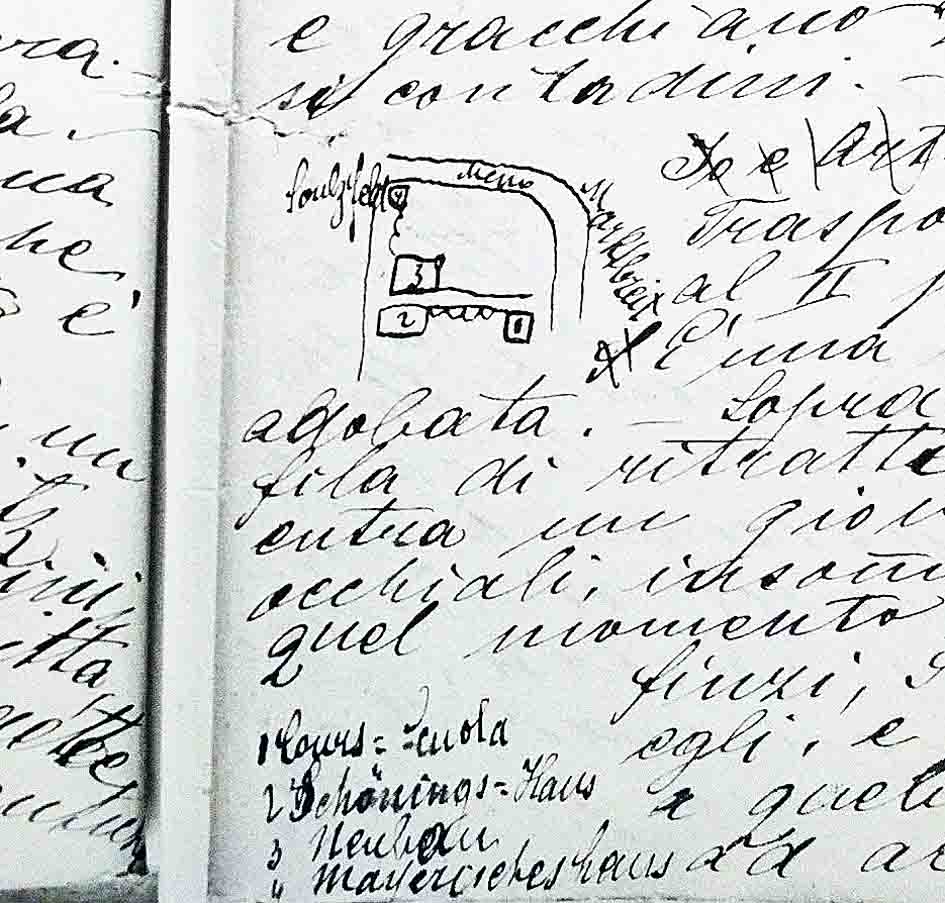
The Brüsselsche Handels-und Erziehungsinstitut was quite famous at that time. The school buildings were “the most handsome in Segnitz” even when the pupils’ accomodation was spartan. Lessons were held in the so-called Curs, or school-house, on the bank of the Main, while accomodation for students and some of the teachers and other personnel were located in separate buildings which were also quite large. Later in his life, Svevo liked to state in his typical tongue-in-cheek manner, that he learned even less than he was taught in Segnitz, but, as a matter of fact, he rapidly picked up the German language and a lifelong affection and admiration for things German. The great writers of German Romanticism and Weimar Classicism were his first introduction to serious literature, and fired him with a literary passion that never left him.
In the sixteenth chapter of his first and partly autobiographical novel Una Vita (“A Life”), Italo Svevo describes an idealized life in the protagonist Alfonso Nitti’s home village in connection with sweet memories of a first love:
She was a young girl who worked for the elderly relative with whom she lived, but had so little to do in the house that she lived like a lady, better than any other girl in the village. Alfonso had danced with her at a church fair and had chosen her mainly because he regarded her as the most beautiful and then because she seemed to him to stand above the others because of her education and the way she dressed. Then a good friendship had developed between them, which was evident in the fact that they exchanged a few words every day, she at the window, he on the street. On some evenings they chatted close together at some distance from the house, that is, out of the village; but even in total darkness he had never dared kissing her hand. He’d paid her exaggerated compliments about her beauty, but never told her that he loved her. [Italo Svevo: “Una vita.” – Romanzi [Opera Omnia III]. Milan: Oglio 1968, 334 f., my translation.]
While this may only read like a distant echo of the enchanting Anna Herz, Svevo’s description of Alfonso’s home village in this chapter is strikingly precise to a resident of Segnitz, although the Main is absent and instead of vineyards and cornfields, the utterly different rocky environment of the Carso above the hills of Trieste is presented. But as for the village, Svevo describes the Hauptstraße, “twisty but clean, where it broadens into an open space, with [Gianni] Creglingis grocery shop in the middle, a low little place…” and there were indeed two inns in Segnitz in the 1870s and also a district “where the poorest of the poor” lived in a small alley that ran parallel to the Hauptstraße – exactly as Italo Svevo describes it in Chapter 16 of Una vita. These passages correspondent astonishingly exactly to the realities in Segnitz, where in Anna’s and Ettore’s time the village mayor, Johann Kreglinger (*1836, †1921) and his family ran a grocer’s shop in a small house in the Hauptstraße right next to the impressive 1588 renaissance village town hall – exactly where the Hauptstraße “broadens into an open space” in front of the town hall. And just as Gianni Creglingi was friends with Alfonso Nitti in the novel Una vita, the real Johann Kreglinger must have been on good terms with the school teachers and pupils in Segnitz, since they were his customers. Kreglinger’s name also appears on the marriage certificate of Anna and Samuel Spier on September 2, 1872 as a witness. It was the first civil wedding ever documented in Segnitz.
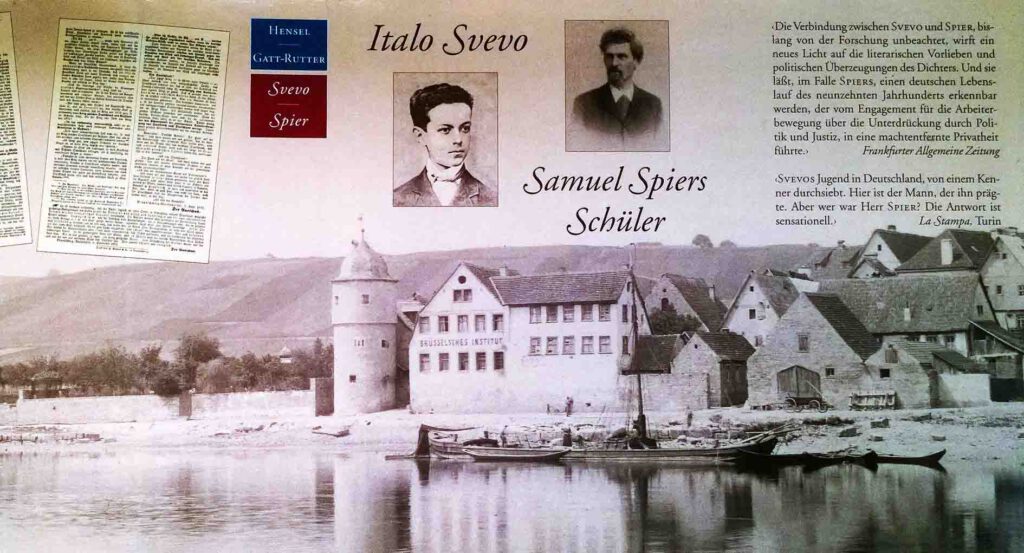
There is another reason why Ettore Schmitz/Alfonso Nitti could have remembered the rare family name Kreglinger: If he indeed had ever met Anna Herz “in the dark” (which seems to be pretty unlikely) or – more likely – longed for it, one of the best places for a romantic meeting would have been the so-called Kreglinger Garten, which is still existing today. It is located in the immediate vicinity west of the school, just outside the old village wall. At that time there were two cozy, romantic pavilions at the far southern end of the garden near the bank of the Main, that would certainly have made the most romantic hangout in the area. One of these pavillons can still be seen today.
Ettore Schmitz was a reluctant traveller, but he was obliged to undergo displacement in two key periods of his life, of which his jouney to Segnitz was the first:
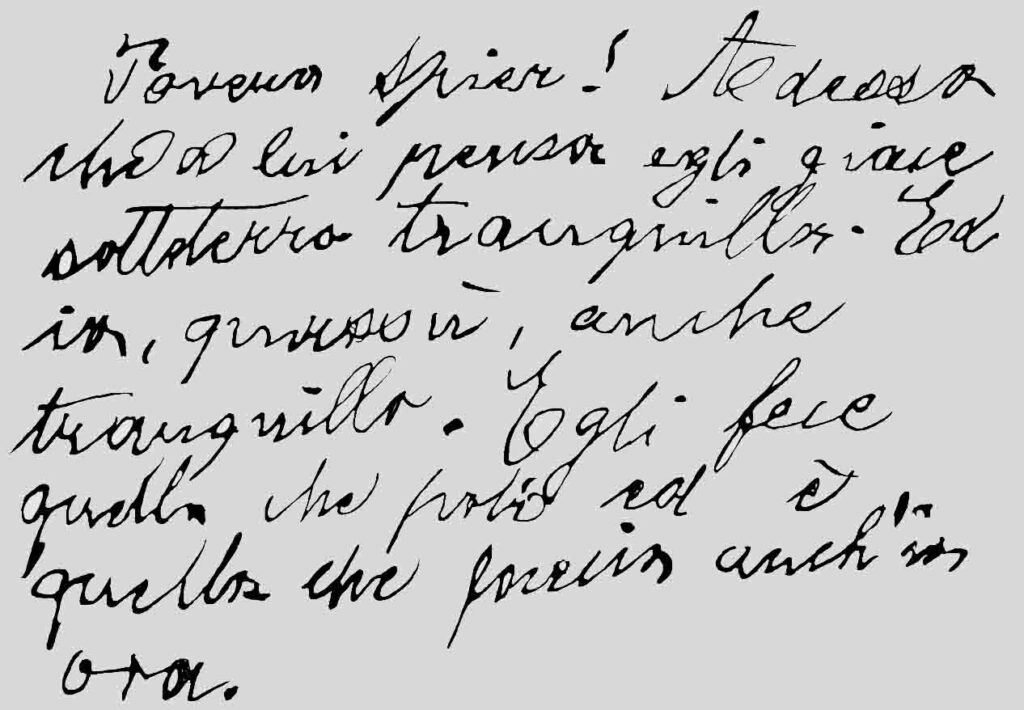
Eccone una di queste isole: piena di luce e di dolore. – “Here is one of these islands: full of light and pain”, wrote Ettore Schmitz on May 1, 1925, when he remembered his travels to Segnitz (1874, 1876, 1913) and probably a visit to his teacher’s former Apartment in Frankfurt on August 24, 1914. Italo Svevo never came closer to Joyce’s flow of thought than in this remarkable piece. It was published posthumously under the title L’avvenire dei ricordi (“The Future of Our Memories”).
A last testimony to his memory of Segnitz is from December 31, 1925, when he scribbled these lines across the pages of a tiny booklet while sitting in a moving train near Verona on his way to London:
Poor Spier! Now that I think of him, he lies quietly underground. And I (am), up here, also quiet. He did his best, and that’s what I’m doing now, too.
Poetic Youth
Ettore studied all the German classics in Segnitz. Goethe and Schiller were his best friends and besides, he was also a social success at the school. He figured in philosophical disputations and formed his own literary debate circle, and in general learned more about literature than he did about commerce. He collected a library out of his savings, which had been, according to Elio, the only thing that was neat and tidy in his room. Elio also names us the authors in Ettores book shelf: Schiller, Körner, Heine and Hauff. He had also bought Goethe’s works, read it and wrote his comments into it, but then he made it for a prize in a raffle and with the proceeds bought Shakespeare in the German adaptation. – It is important to note that the excellent German adaptation of Shakespeare by August Wilhelm Schlegel, Dorothea Tieck and Ludwig Tieck, which appeared between 1797 and 1810, was actually not a translation, but eine Nachdichtung, a re-compost. The Tiecks and Schlegel introduced a different – to be precise: a “romantic” – Shakespeare to the German audience. Shakespeare in German, as learned by heart by the young Italo Svevo in Segnitz, differs from what one would expect from knowing the English original from the 16th and early 17th century.
He read right through several nights learning Hamlet by heart and then wanted to go on to King Lear. But his sleepless nights had made him pale, Spier found out the cause, and confiscated the book. Still Ettore lay awake for several more nights brooding over Sein oder Nichtsein (“To be or not to be”). When Elio suggested that he should read the Italian classics, Dante and Petrarch, rather than Schiller and Goethe, Ettore laughed in his face: “Schiller is the world’s greatest genius,” he replied. [John Gatt-Rutter: Italo Svevo. A Double Life. New York: Oxford University Press 1988, 29.]
Livia Schmitz née Veneziani, Italo Svevo’s wife, wrote almost 75 years later in her Memoirs of Italo Svevo, first published in Trieste 1950:
When he was eighteen and had completed his studies, Ettore left school and Germany, and returned to Trieste […] With him he brought a favourable memory of the school’s headmaster, a strict, austere but just man whose authority he had accepted with filial feelings. In his heart too, he kept a tender memory of an idyll: the image of the headmaster’s [sic] niece, young Anna Herz, who had preferred him to his brother Adolfo. Sadly, this threw a shadow between the brothers, which Ettore never liked to recall. Anna was older than Ettore, and there was a touch of motherly protectiveness about her feelings, apparent in an inscription in the works of Shakespeare, presented to him when he left school. [Livia Veneziani-Svevo: Memoir of Italo Svevo. Translated by Isabel Quigly. Preface by P. N. Furbank. London: Libris 1989, 9.]
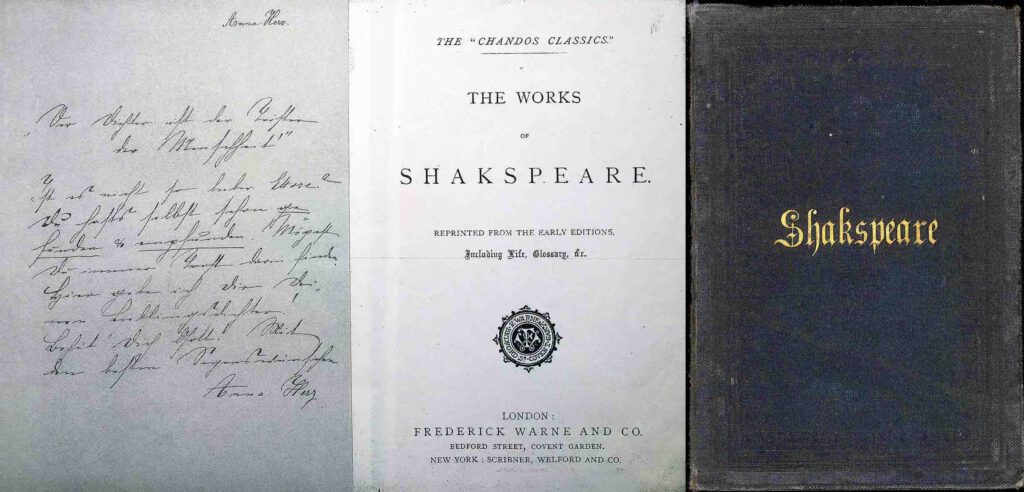
Anna’s inscription, written in fine Kurrent, the traditional German script, reads and translates:
„Der Dichter ist der Tröster
der Menscheit!“
.
Ist es nicht so, lieber Ettore?
Du hasts selbst schon ge-
funden & empfunden. Mögest
Du immer Trost darin finden.
Hier gebe ich Dir Dei-
nen Lieblingsdichter!
Behüt’ Dich Gott! Mit
den besten Segenswünschen
Anna Herz
.
Translation:
.
“The poet is the consoler of mankind!”
Isn’t that so, dear Ettore? You have already found and felt it yourself. May you always find comfort in it.
Here I give you your favourite poet!
With the best of blessings.
Anna Herz
This Shakespeare edition is a unique gem. Firstly, it had been Anna’s personal copy and is very likely her only possession that made it into the 21st century. Secondly, it is also one of few books to have escaped the destruction of Italo Svevos personal library in 1945, and thirdly it is – together with two school books and a poetry album – Svevos earliest surviving possession other than some family photographs.
He looked after it carefully, and it shows no trace of rough handling or grumbiness. It does not fall open naturally at any one or few places, but Hamlet, Romeo and Juliet, and Othello seem to have been most frequented – plays which each have a relevance to specific aspects or phases of Ettore’s life. [John Gatt-Rutter: Italo Svevo. A Double Life. New York: Oxford University Press 1988, 30.]
![Ettore’s Poetry album and Samuel Spier’s amazingly short entry: „Steh immer früh auf !! – Dein Freund Sp.“ [“Always get up early !! – Your friend Sp.”] Photos from 1986 © 2021 H. M. Hensel. Ettore’s Poetry album and Samuel Spier’s amazingly short entry: „Steh immer früh auf !! – Dein Freund Sp.“ [“Always get up early !! – Your friend Sp.”] Photos from 1986 © 2021 H. M. Hensel.](http://www.hmhensel.com/wp-content/uploads/2020/04/ettores-poesiealbum-aussenSpier-klein-300x240.jpg)
Anna began her entry with a seven-line quote that makes one think of Schiller at first sight. Or, perhaps, the passage could come from a German adaptation of a Greek classic or even from the Old Testament – think of Job 28.
Her quote translates:
Many virtues have the gods
Planted into the soul of the mortal.
All will grow & blossom,
if man does not disturb
their flourishing.
But the one and highest in life
he must achieve for himself,
that is the most difficult, the right measure.
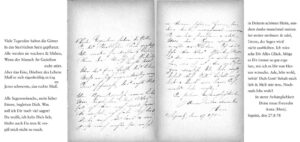
But neither is this quote from one of the well-known classics nor is it from the Bible. Anna found it in the historical play Corona von Saluzzo by Ernst Raupach, which was premiered in 1834 at the Burgtheater in Vienna and ran successfully for many years on various stages in the German Confederation. The then 23-year-old Richard Wagner, for example, liked Raupach’s play so much that he announced to his future wife and actress Minna Planer in a glowing love letter on June 26, 1836 that he would get it for her. The quoted passage by Anna is at the end of an intermediate act between the third and the fourth act.
Anna continues:
All blessings, my dear
Ettore, accompany you. What more
should I tell you?
You know, you are dear to me,
remain faithful, too & do
not forget me so quick
in your beautiful home, but
sometimes think of me.
Continue being ambitious & noble,
Ettore, the blessing
will not be absent. I wish
you All Luck. May you
always do as well
as I wish it to be for you from the bottom of
my heart. Ade, farewell,
may God protect you! Keep me
dear & stay true to me.
Again farewell!
.
In constant devotion
.
Your loyal friend
.
Anna.
.
Segnitz, 27.8.78
Anna Herz was three and a half years older than Ettore, but none of my fellow Svevo enthusiasts is reading exclusively motherly feelings into this beautiful dedication.
It is striking that besides Samuel Spier no other teacher is represented, neither in Ettore’s nor in Elio’s album. But amazingly, Anna Spier, the headmaster’s young and well-read wife (and future art critic and literary expert), wrote a full three pages entry for Ettore. It is by far the longest entry in both Ettore’s and Elio’s albums – and there is Shakespeare again, with Hamlet, exactly the piece which Ettore had learned by heart until Samuel Spier confiscated the book from him.

Anna Spier almost fully quotes Polonius’ words of farewell to his son Laertes from Shakespeare’s Hamlet act 1 scene 3 in Schlegel’s German adaptation: “There, my blessing with thee. And these few precepts in thy memory…” and then writes:
Dear Ettore!
.
The foregoing parting words give you wise commandments from a wise mouth on your path in life. I have put this ahead of any outburst of feelings, because I wish above all that you should prove yourself in real life as one of the noblest.
.
I beg you, never become indolent towards yourself.
.
Set up an ideal person in yourself, whom you should and want to meet in all demands; he will be your support and guide.
.
And if you do not forget him, you will never forget your teenage years in Segnitz; and when you think of Segnitz, you will think of me too. So I hope you will empathize with how much love I met you every hour and acted upon, and how your innermost well-being was important to me – and still is.
.
This love will always be there for you as often as you come in sorrow or joy!
.
Take this promise as a farewell gift!
.
For all conflicts that you may face in your profession, I give you Goethe’s uplifting word as a slogan:
.
“Day or night, it matters never,
“I will praise man’s earthly fate;
“Thinking righteous thought, forever
“He’ll have beauty, he’ll be great!”
.
May everything be a blessing for you, you, dear son!
.
20./8.78 Segnitz a/M. Anna Spier
In contrast to Shakespeare’s Hamlet in German, Anna Spier seems to have quoted Goethe from memory, because the first two lines of the third stanza of his 1826 poem „Schwebender Genius über der Erdkugel“ („Zwischen oben, zwischen unten…“) actually begin slightly different:
Alle Tag’ und alle Nächte
Rühm’ ich so des Menschen Loos;
Denkt er ewig sich ins Rechte,
Ist er ewig schön und groß.
… for which I used above the English adaption from Edwin H. Zeydel: “Hovering Genius over the Earth-Sphere” („Pointing upward and below…”) – Poems of Goethe. A Sequel to Goethe, the Lyrist. Chapel Hill 1957, 123.
On the same day, Anna Spier also wrote a page in Elio’s album, starting with a well-known German saying:
Wer soll Meister sein? Wer was ersann!
Wer soll Geselle sein? Wer was kann!
Wer soll Lehrling sein? Jedermann!
.
(“Who should be a master? Who came up with something! – Who should be a journeyman? Who can do something! – Who should be an apprentice? Anyone!”)
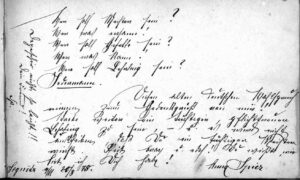
’
and she continues:
Take this old German motto as a memorial from me!
.
Keep striving to be a good, dutiful apprentice – and you will not fail to become a good master. Stay good and noble! You know how dear you are to me.
.
Anna Spier
.
20./8.78 Segnitz a/M.
Samuel Spier pasted his four words across the left corner of his wife’s page so that the two together described four pages for Ettore – Anna Spier even calls him „dear son“ –, but only one for Elio who never got involved in Segnitz and remained downright unhappy there. On the other hand, at least Elio’s classmates had more for him. Elio has in fact many more entries from classmates and friends on his album than Ettore, including one from his brother Adolfo, who did not write into Ettore’s album. This seems to confirm Livia Schmitz’s report about the rift between the two brothers in Segnitz over Anna Herz. As for the time of his arrival in Segnitz 1886, Elio has nothing about this rift in his diary, which however, according to Livia, latter persisted even after their return to Trieste.
In summary, one can safely say that the Spier team in Segnitz gave its protégés pretty much the same thing on their way through life that clinical psychologist Jordan B. Peterson gives his readers today in the four hundred pages of his rightly best-selling book 12 Rules for Life: Stand up straight, clean up your room, become competent, listen, be honest, leave the world better than you found it… The difference to Peterson is that both Anna and Samuel Spier together only needed four pages for their message – and even this only if we include the full-page quote from Shakespeare, another half page from Goethe and the well-known saying for Elio.
Anna Herz also wrote a farewell to Elio’s album and this time her words do indeed read motherly. She starts quoting the philosopher, literary figure and socialite Friedrich Heinrich Jacobi (*1743 – 1819):

“A thing of the future is man and strive he
must ceaselessly! On the path of the true good however,
near the joys of hope, he also finds
the calm of pleasure.”
Then she continues [almost literal translation is intended to preserve Anna’s contemporary maternal style and tone]:
“Strive also you, my dear Elio, always on, to become well, noble and capable so that by the people you will be loved, respected & one day become a decent member of human society. – All blessings to you, may you become as happy as I am wishing it to you with all my heart. Stay loyal, do not quite forget me in your beautiful home, know always & at every hour that you are so beloved and dear to me.
.
May God protect you, now & always! Farewell, my good Elio, I beg you, do not forget me completely
.
Your loyal friend
.
Anna Herz”
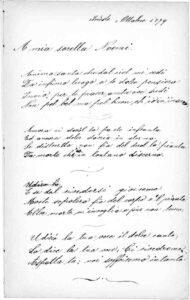
As already mentioned, Ettore has significantly fewer entries in his album than Elio, although in contrast to his younger brother in Segnitz he is said to have been a “social success”. Indeed, Ettore’s rather thick album actually contains mostly blank pages. But, almost completely hidden, on one of the back pages, it preserves a small literary treasure: In this secret place Ettore put into words his pain over the sudden death of his beloved sister Naomi, who was, exactly as Anna Herz, three years older than him. A remarkable entry that had been forgotten for over a century when I found and photographed it in 1986 in the presence of Italo Svevo’s daughter Letizia. Elio had mentioned the poem in his diary as being from October 1879, but he did not pass it on. Unfortunately it was lost for even more years: Despite my indication, an editor of Elio Schmitz’s diary still wrote in 1999 that the poem was lost. It was only published for the first time in 2004.
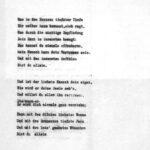
In the drawer in which the poetry album was carefully kept by Svevos daughter in 1986, I even found another treasure: A sheet of paper with the letterhead of E. Schmitz Schiffsbodenfarben “Moravia” from World War I with a most remarkable poem about deeply felt love and pain on it, written in German.
“The juxtaposition of Ettore’s filial regard for Spier with his romance with Anna may be casual, as also the fact that Anna should give Ettore the works of the author which Spier had confiscated from him, but it all smacks of Freudian ‘family romance’. All Svevo heroines have names that begin and end in A. Of all the women closely associated with Ettore Schmitz, only his mother Allegra and Anna Herz [and Anna Spier who adressed him ‘dear son’ in 1878] shared this distinction.” [John Gatt-Rutter: Italo Svevo. A Double Life. New York 1988, 30 – Anna Spier’s first name was not yet known at the time of research for this book.]
Segnitz in the 19th Century: A Gateway to the World
Samuel Spier and his wife dissolved the Brüsselsche Institut in September 1881 and moved to Frankfurt where Samuel largely lived the life of a private scholar. He met regularly with his journalist friends of the Frankfurter Zeitung and the Frankfurter Volksstimme, gave public and private lectures and became a leading member of the Freies Deutsches Hochstift, a highly respected Association for Sciences, Arts and General Education. Spier was also the driving force behind the establishment of the Frankfurt Consumers’ Co-operative in the 1890s and was elected its first chairman, while Anna made a name for herself as a renowned art critic and literary expert. She rarely appeared in her circles together with Samuel, but her husband’s connections appeared to be helpful with some of her early contacts with publishers and artists.
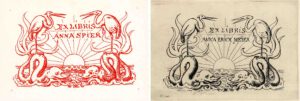
After Samuel died in 1903, Anna moved to Munich where she was close to many of her artist and literary friends and to her publisher Edgar Hanfstaengl. She married Erich Meyer (1874-1928), a well-known professor of medicine, in 1910. Meyer had been teacher to Herman Blaschko (*1900-1993 – see p. 45 in this link) and other famous physicians and was a recognized editor of two standard medical works. He successively headed hospitals in Munich, Strasbourg and Göttingen but sadly died in an accident while walking in the Swiss mountains in his holidays 1928. Anna, who after her marriage to Meyer signed as AnnaErich Meyer (“AnnaErich” mostly written together), compiled and edited an unfinished script of her late husband, which is still quoted today: Vom Werden und Wesen des ärztlichen Berufes (“On the development and nature of the medical profession.”). This was her last literary work. She died in Göttingen in 1933. The only known picture of her made after 1914, a black and white photo of a lost painting by Hermann Hirsch is in the estate of Max Born in Oxford.
Anna’s and Samuel’s son Oscar became a lawyer in Frankfurt. When his father withdrew from his posts, he followed him as an active member of the Freies Deutsches Hochstift. Like his sister, who died after a surgical intervention in 1921, he was unmarried and childless. Oscar Spier was expropriated in an especially mean and devious way and finally driven to his death by the National Socialists in 1940 at the age of 65. His heirs named by him have all became victims of the Holocaust. His parent’s extensive correspondences and written legacies were destroyed. Their letters have only been preserved sporadically in other legacies. Oscar Spier’s valuables were auctioned, including the 1890 „Portrait of Mrs. Anna Spier“ by Hans Thoma shown above, which is now in the possession of the Germanic National Museum in Nuremberg. The museum’s press office did not think it necessary to answer my two-time inquiries as to how and through whom the painting, which had been illegally extracted from its Jewish owners (even under the 1940 law), got into the museum after the war.
As for Anna Herz, she has very likely left Segnitz in 1881 at the latest. We do not know when exactly she migrated to the U.S. – presumably at the same time with her parents and her sister Marie (* August 2, 1854 Hochberg – February 24, 1924 Houston) –, but we may assume that she went initially to New York or Cincinnati, where her older brother Max had established himself as a businessman already at a very young age.
Max Herz (born September 10, 1853 – October 6, 1938) seems to have been a particularly capable and adventurous man. According to his obituary in the Galveston Daily News from October 7, 1938, he was educated in private schools in Frankenthal and Mannheim and later at Heidelberg. He came to the United States in his very early youth, locating in New York and Cincinnati. He was engaged in the cigar brokerage business (“one of the hardest – and least recognized – professions in the cigar world”) and traveled throughout the entire South for more than 50 years. On one of these trips he met Betty Eldridge, his future wife, in Galveston in the late 1870s. After their marriage, the couple stayed in Galveston.
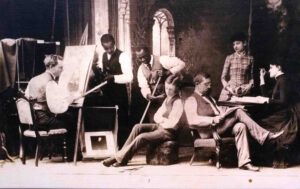
’
Anna Herz, her sister Marie and her mother Jeanette also moved to Galveston afterwards. Ferdinand Herz, Anna’s father, seems to have died either during the crossing or shortly after his arrival. Nothing is known about the circumstances of his death; his grave is unknown. Anna Herz married New Orleans born Jacob Samuel Miller in 1884. Jacob S. Miller was a co-founder of Miller Bros. Workclothing Manufacturing Co. 1866 in new Orleans (but they also advertised for instance as wholesalers for rubber and other goods) and moved to Galveston ten years later.
At the June 1, 1900 census, Anna s older unmarried sister Marie Herz also lived with the Miller family at 1912 Winnie Street, Galveston, Texas. Marie probably made herself useful in the household or in the company of her brother-in-law and her sister. It must have been happy years. Occasional reports in the Galveston Daily News only mention Miller Bros. in messages that indicate booming business.

But then the deadliest natural disaster in United States history struck the city. The Great Galveston Hurricane of September 9, 1900 left approximately 8,000 dead and more than 10,000 homeless in Galveston, out of a total population of fewer than 38,000, and destroyed about 7,000 buildings of all uses; every single dwelling in the city suffered some degree of damage. The disaster ended the Golden Era of Galveston, as the hurricane alarmed potential investors, who turned to Houston instead. The Miller family initially survived the hurricane, but Anna Herz’s mother’s tombstone indicates that she died only a month after the storm, in October 1900. Miller Bros. moved its headquarters to Houston around 1910. Anna and Jacob Miller stayed in Galveston, but some time after her husband’s death in 1917, Anna was with her son when Miller Bros. moved to Houston completely.
Both Anna Miller née Herz and her sister Marie seem to have lived and cared for their family. In any case, nothing is known about other activities. I found almost no trace of Anna Herz in local history, contemporary directories and newspapers except in rare cases of society events. There she is occasionally mentioned – as “Mrs. Jacob S. Miller”, never with her own name: Anna Miller.
In addition to eight respected citizens of Galveston who acted as pallbearers, we also find the closest grieving relatives in the aforementioned obituary for Max Herz from 1938: Max’s son Irwin M. Herz, trustee of the City National Bank, his daughter, Miss Lilian E. Herz, member of the editorial board of Galveston News, his sister “Mrs. J.S. Miller from Houston” (= Anna Herz) and several nieces and nephews. But in fact, Anna Miller, nee Herz, died just eight days after her brother Max, on October 14, 1938.
Anna had two children with Samuel: Samuel Irving Miller (September 2, 1885 – May 9, 1944) and Beulah Miller (February 1888 – June 12, 1979). Samuel married Cecile Haas Miller of San Antonio. When they married they still lived in Galveston until around 1920 when they moved Miller Bros. to Houston. They had two children: Louis Adoue Miller (Barbara Eaker’s father) and Samuel I. Miller Jr. – According to an announcement in the Galveston Daily News (Society page “Women’s Varied Interests”), Beulah married William W. Munzesheimer of Marietta, Oklahoma on February 2, 1916 in Galveston. Beulah had two children: Anna who died in infancy and Jane Gross.
Anna Herz’s descendants and relatives, among them Irwin M. Herz, Jr. of Galveston (Max’s grandson and Anna’s grand-nephew) and Barbara Eaker (Anna’s great-granddaughter and closest relative today), have no pictures or autographs of Anna Herz. All documents from the 19th century, if there had been any, were probably destroyed in the Great Galveston Hurricane. Barbara Eaker’s father also did not learn much about his grandmother because both Anna Herz and her brother died shortly after he was born. And Barbara’s grandfather, Anna’s son, died when she was just a baby.
Apart from the civil papers preserved in Ludwigsburg and Houston archives, Anna Herz’s Shakespeare edition, which she gave to the future writer Italo Svevo in 1878 with a dedication as a parting gift, and her two entries in Ettore’s and Elio’s poetry albums are the only documents we have of her today. They are now preserved in the Museo Sveviano in the Biblioteca Civica in Trieste.
♦
Note: This is the first and very short draft of an upcoming illustrated book. Thank you for pointing out any errors and substantial additions that may be included in the book with great pleasure (please send to hmhensel{ät}YAH00.de). – „Ettore, Anna and the Spiers“ was originally scheduled to appear at the end of this year, on the occasion of the 160th anniversary of Italo Svevo’s birthday, but this is no longer feasible because of the abundance of new material. The English written above is not my mother tongue. Be gracious in your judgment. ;–)) hmh.